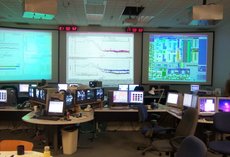LIGO
|
|
LIGO stands for Laser Interferometer Gravitational-Wave Observatory. Cofounded in 1992 by Kip Thorne and Ronald Drever, of Caltech and Rainer Weiss, of MIT, LIGO is a joint project between scientists at MIT and Caltech. It is sponsored by the National Science Foundation (NSF). At the cost of $365 million (in 2002 USD), it has been the largest and most ambitious project ever funded by NSF (and still is as of 2004). The international LIGO Scientific Collaboration (LSC) is a growing group of researchers, some 400 individuals at roughly 40 institutions, working to analyze the data from LIGO and other detectors, and working toward more sensitive future detectors.
LIGO's mission is to observe the theoretical gravitational waves of cosmic origin. In August 2002, LIGO began its search for cosmic gravitational waves that are theoretically created in supernova collapses of stellar cores (which form neutron stars and black holes), collisions and coalescences of neutron stars or black holes, rotations of neutron stars with deformed crusts and the remnants of gravitational radiation created by the birth of the universe.
The Livingston Observatory, located in Livingston, Louisiana, houses a laser interferometer, consisting of mirrors suspended at each of the corners of a gigantic L-shaped vacuum system, measuring 4 kilometers (2.5 miles) on each side. A laser beam is sent toward a beam splitter at the vertex of the L, branching into precision laser beams that enter the arms and are contained there in Fabry-Perot cavities ("storage time") to increase the total light path length. Eventually, the light returns through the beam splitter. A portion of this light branches off to be detected immediately, while the rest reflects off a mirror that recycles the light back toward the arms. Fundamentally, the interferometer senses small motions of the mirrors, which are caused by gravitational waves.
The Hanford Observatory, located near Richland, Washington, on the Hanford Nuclear Reservation, houses a nominally identical laser interferometer as the Livingston Observatory. Also, there is a smaller, though no less complicated, interferometer housed in parallel. This second detector is half the length (2 kilometers), but has twice the optical finesse and thus the same storage time and shot noise sensitivity. The half-length interferometer exists to detect displacement noise, to which it responds twice as much
The theoretical gravitational waves that originate hundreds of millions of light years from Earth are expected to distort the 4 kilometer mirror spacing by about 10-18 m (a hydrogen atom is about 5×10-11 m). These waves were first predicted by Einstein's Theory of General Relativity in 1916, when the technology necessary for their detection did not yet exist. Some progress in detection occurred with the work of Joseph Weber in the 1960s on resonant bar detectors, which continue to be used at several sites worldwide. Now, at the turn of the 21st century, interferometer physicists believe that technology has reached the point where detection and of gravitational waves--of significant astrophysical interest--is possible.
As of May 2005, the LIGO detectors have demonstrated sensitivities within a factor of 2 of their design.
External links
- LIGO Laboratory home site (http://www.ligo.caltech.edu/)
- LIGO Hanford Observatory (http://www.ligo-wa.caltech.edu/)
- LIGO Livingston Observatory (http://www.ligo-la.caltech.edu/)
- Amos, Jonathan. Gravity wave detector all set (http://news.bbc.co.uk/2/hi/in_depth/sci_tech/2003/denver_2003/2774163.stm). February 18, 2003. BBC News.
- Earth-Motion studies (http://www.ligo-wa.caltech.edu/ligo_science/earth_motion.html) A brief discussion of efforts to correct for seismic and human-related activity that contributes to the background signal of the LIGO detectors.ca:LIGO

